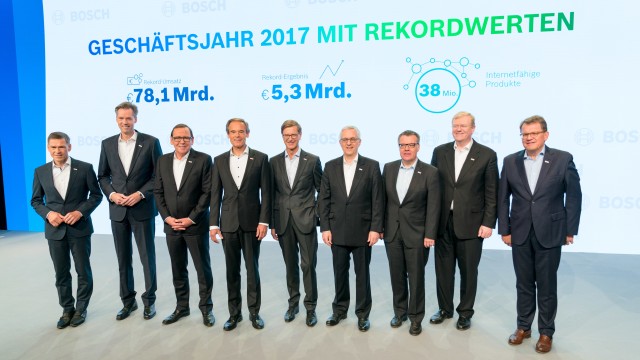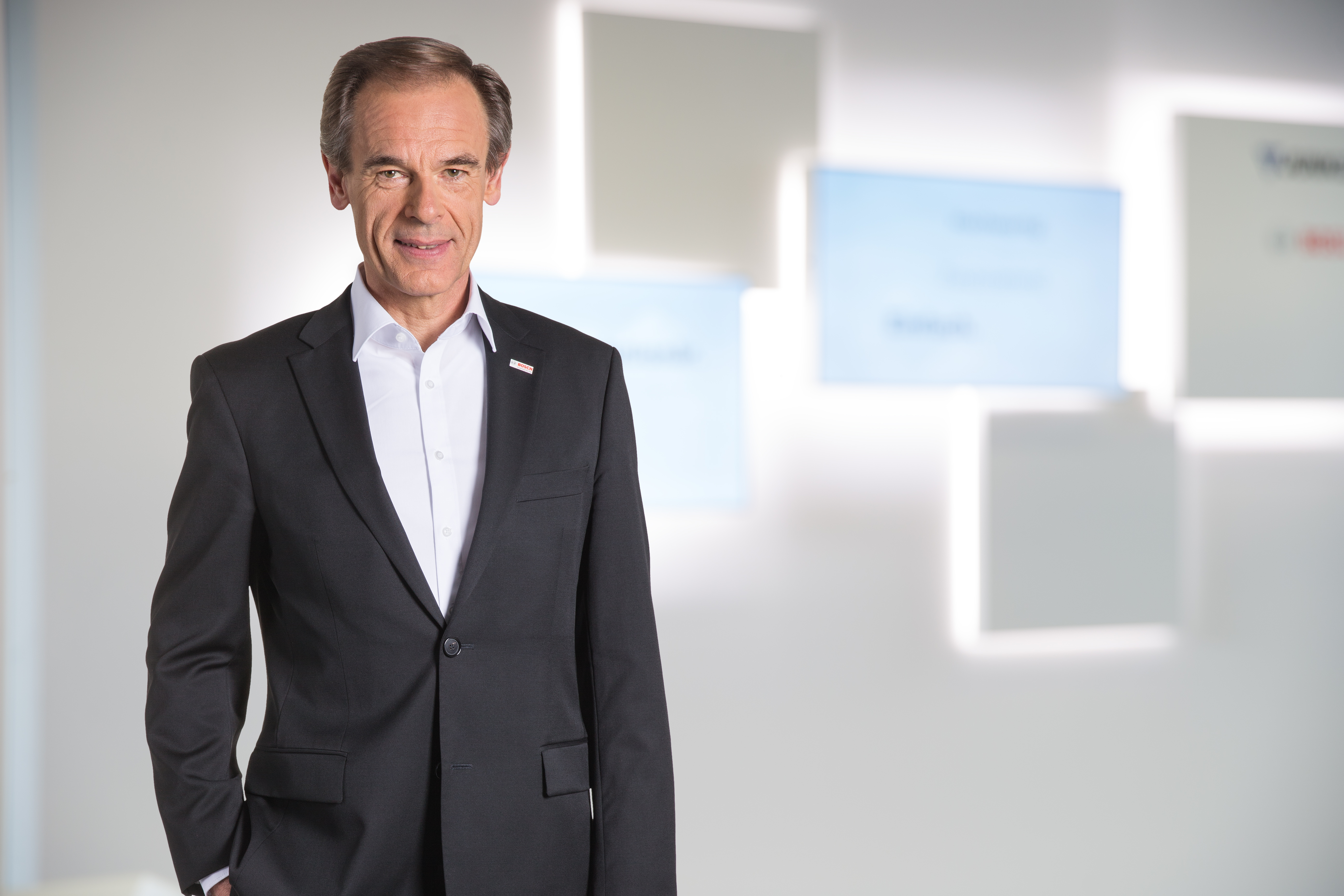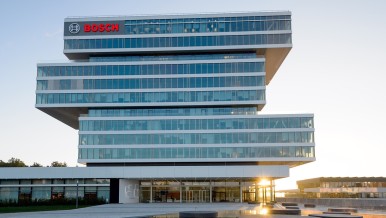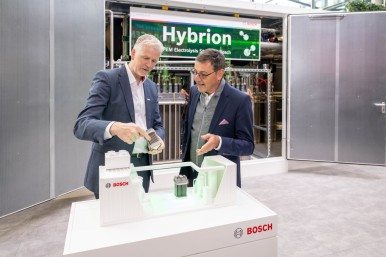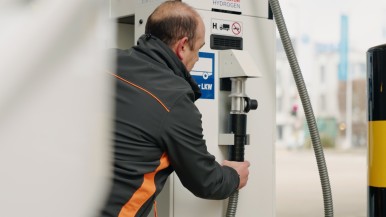The issues of climate change and urban air pollution are highly complex. In addition to technological solutions, they always require political decisions as well. To name just one example, industry shouldn’t wait for the long drawn-out implementation of the Paris climate agreement – it should anticipate it. That is precisely what I consider to be the deepest core of Bosch’s strategic imperative, “Invented for life” – applying the best technology possible to protect our natural environment, even above and beyond political directives.
For road traffic, this means we want to make it accident-free and stress-free, but especially as emissions-free as possible – regardless of whether the vehicle consumes fuel or electricity. That’s why we are investing billions of euros in electromobility. Today we say there’s no car on the planet without a bit of Bosch; tomorrow we will say no electric car without a bit of Bosch. At the same time, we are working on the future of diesel. Our engineers have developed solutions over the past few months that significantly reduce the emissions of diesel engines. This breakthrough offers the opportunity to shift the heated debate over diesel into new territory and, hopefully, bring it to a close.
- With this new exhaust technology, blanket driving bans in the centers of the world’s major cities will no longer be an issue. Why? Because we now have the technology to resolve the problem of nitrogen oxides in road traffic. Diesel can now resume its success story.
It was diesel’s critics that particularly spurred our engineers on. Their results are plainly visible, or better yet: measurable. Bosch technology allows today’s real diesel emissions to fall far below the legal limits due to take effect in 2020. This is the technology that Bosch stands for: “Invented for life,” not for the lab.
But our technological breakthrough is only one part of the story; Bosch wants to go further. What we want is more transparency and realism, whenever measurements relating to road traffic are made. In other words, we’re not just aiming to measure and reduce real driving emissions (RDE), as that would leave out consumption and CO2. Instead, we have to take real driving consumption (RDC) into account. From RDE to RDC – this summarizes our objective. Creating more clarity for climate action calls for consumption and CO2 to be measured under realistic conditions. Low fuel consumption in a test bay does little to help the climate – we must make room for reality here, too.
Transparency with regard to CO2 also means including all carbon-dioxide emissions attributable to road traffic: from fuel production and electricity generation to actual consumption on the road. Taking such a comprehensive view may result in the realization that it’s better to drive the right diesel vehicle than the wrong electric car. The main point here is not an either-or proposition between combustion engines and electromobility – instead, our aim is transparent eco- and climate-friendliness in all drive systems.
Of course, this is also an important issue for Bosch from a commercial point of view. Automotive drive systems, whether conventional or alternative, are our core business – we’re talking about tens of thousands of jobs. There is no other domain in which our company’s environmental, commercial, and social responsibilities intersect to the same extent. That is why we’ve chosen it as the focus of this annual press conference.
The presentations today will also serve to explain our business situation. In this regard, there are three key points:
- First, we can look back on a successful financial year in 2017. Sales increased more than expected, and margin saw encouraging growth, too. This is due to all Bosch associates, and I wish to thank them for that.
- Second, our forecasts for the business year 2018 are more cautious. We see several risks, but still aim to further increase sales and especially margin as well.
- Third, we are not only securing our existing business areas this year, but planning to open up new ones: electromobility and connectivity.
I will go into this point in more detail when I talk about strategy. Now, however, I will hand over to Mr. Asenkerschbaumer, who will provide a review of last year and a forecast for this one ...
The financial figures: a successful 2017
Ladies and gentlemen,
2017 was a successful year for the Bosch Group. Across the board, I can present you with good figures.
This success was partly due to the generally robust economic fundamentals:
- the global economy did better than we had originally anticipated at last year’s annual press conference – and it outperformed the previous year as well. Global GDP climbed 3.2 percent, compared with 2.7 percent in 2016.
- Automobile production worldwide likewise exceeded our expectations in 2017, with growth of 2.4 percent. Yet, the momentum was clearly down compared with 2016, when the economy grew roughly 4.5 percent.
- What was pleasing was the substantial recovery of the mechanical engineering sector. Positive stimuli came from all regions, but most notably from China.
- Other segments of importance for us, private consumption and global construction activity, also developed favorably overall worldwide.
At 78.1 billion euros, the Bosch Group's sales revenue is slightly higher than the preliminary figure published in January. Compared with the previous year, sales revenue increased substantially by 6.8 percent. Yet at roughly 140 million euros, there were no appreciable consolidation effects in 2017. The sale of the Starter Motors and Generators division completed at the end of the year will not impact sales revenue until 2018. That said, reported sales revenue was again burdened by substantial exchange-rate effects of 1.2 billion euros. Adjusted for these effects, our sales revenue grew by an even greater margin of 8.4 percent.
All business sectors, and especially Mobility Solutions, grew their sales revenue significantly in 2017. Here, sales revenue increased 7.8 percent, and indeed by as much as 9.4 percent, if we adjust for currency effects. We did well across our entire product range – in powertrain technology with state-of-the-art systems for gasoline direct injection, but also with advanced diesel technology in the commercial vehicles segment as well as with exhaust-gas treatment systems. That allowed us to compensate for lost ground in the European passenger-car segment. In 2017, we again benefited from continued growth in demand for driver assistance systems, advanced display and infotainment systems, and new generations of thermal management systems. Our e-bike business was very successful, as were our other activities in the two-wheeler market.
In the Industrial Technology business sector, specifically in the Drive and Control Technology division, we benefited from the recovery of the mechanical engineering market, exciting innovations, and the realignment undertaken in recent years. Sales revenue rose 7.8 percent to 6.8 billion euros, or by as much as 9.2 percent after adjusting for exchange-rate effects. The division is driving forward the expansion of its activities in Industry 4.0, both as a leading user in our own plants and as a leading provider to our customers. Yet the focus here is not merely on new plant, but also on equipping and modernizing existing plant, where data analytics and connectivity can deliver substantial gains in productivity. In contrast, we are not satisfied with the downward sales trend in the Packaging Technology division.
However, both the Consumer Goods and Energy and Building Technology business sectors posted an encouraging increase in their sales revenue. In 2017, Consumer Goods generated sales revenue of 18.4 billion euros, thus climbing 4.5 percent in nominal terms or 6.7 percent after adjusting for exchange-rate effects. Both its divisions – BSH Hausgeräte and Power Tools – contributed to this development. The focus at BSH Hausgeräte was on connectivity and the expansion of its international business, particularly in high-growth markets such as China and India. Power Tools is proving successful with innovations that are very closely tailored to the needs of users and is now in the process of expanding its international business in emerging markets as well.
Sales revenue in the Energy and Building Technology business sector rose 4.1 percent to 5.4 billion euros, or by 5.8 percent if we adjust for currency effects. Because of its strong market position in the United Kingdom, the Thermotechnology division in particular was hit hard by the weakness of sterling.
An important driver here is increasing connectivity, with the result that the Thermotechnology and Building Technologies – formerly Security Systems – divisions are increasingly collaborating in joint projects. In this context, the Security Systems division was renamed Building Technologies to reflect its significantly broader portfolio, which now extends far beyond security technology. For instance, we are considerably expanding the installation business in the building and energy sector. The Bosch Global Service Solutions division was again able to produce double-digit growth.
Business performance varied widely from region to region. Sales in Asia Pacific again saw double-digit growth of 13.5 percent, or as much as 16.5 percent after adjusting for exchange-rate effects. Developments in Europe were also pleasing, with growth of 5.6 percent, or 6.6 percent if we adjust for currency effects. In South America, we were able to recover from the past years of economic downturn and generate growth again, up a nominal 16.4 percent, or 13.2 percent after exchange-rate effects. In North America, by contrast, we had to shoulder a nominal 2 percent contraction in sales revenue owing to the challenging economic fundamentals in the automotive sector there. After adjusting for currency effects, sales revenue stagnated.
Aside from sales revenue, we also managed to substantially boost earnings overall and in particular our EBIT margin in 2017. When looking at the figures for 2016, it should be noted that our presentation of 2016 earnings partly reflects a change of methodology as regards the net interest expense on pension provisions. As is common practice at most companies, we now present the net interest expense under the financial result; the figures for the previous year have been restated accordingly. EBIT thus more closely reflects the development of operations.
On a like-for-like basis as well, our 2017 EBIT of 5.3 billion euros and our operating margin of 6.8 percent were significantly up on the previous year. The difference between this figure and the disclosed 2017 EBIT of 4.9 billion euros essentially stems from depreciation and amortization in connection with the full acquisition of the former joint ventures BSH Hausgeräte and Automotive Steering in 2015.
A look at the development of earnings broken down by business sector also reveals a pleasing picture. Here too, we have restated the figures for 2016 to ensure comparability as regards methodology. Mobility Solutions achieved an operating result of 3.4 billion euros, compared with 2.8 billion euros in the previous year. In the Industrial Technology business sector, the good development of business coupled with the positive impact of realignment measures led to an increase in the operating result to roughly 220 million euros compared with roughly 75 million euros in 2016. We were very successful in the Consumer Goods business sector, which again returned an operating result of 1.5 billion euros, and once again an operating margin in excess of 8 percent. Despite significant exchange-rate burdens, the Energy and Building Technology business sector managed to match the previous year’s earnings level.
We achieved this good result despite the substantial upfront investment in the transformation that lies ahead. Research and development cost reached approximately 7.3 billion euros, compared with 6.9 billion euros in the previous year. Owing to the good development of sales revenue, research and development cost as a percentage of sales decreased slightly to 9.3 percent, compared with 9.5 percent in the previous year. We are making heavy upfront investments in driver assistance systems – more specifically in autonomous driving functionalities, display and infotainment systems, and sensor technology. At the same time, we are still focusing on developing state-of-the-art powertrain technology, both for even more efficient combustion engines and for e-mobility.
Aside from our expenditure on R&D, we have also increased slightly our expenditure on property, plant, and equipment. After rounding, however, expenditure here was still on the previous year's level of 4.3 billion euros. These heavy upfront investments related to efforts to strengthen technological expertise and competitiveness, to new product launches, and to the expansion of our manufacturing capacity. Again, Mobility Solutions should be especially mentioned in this context. Roughly three-quarters of total capital expenditure, or 3.3 billion euros, was injected into this business sector. We also greatly increased capital expenditure in Consumer Goods to 800 million euros from 720 million euros in the previous year, partly in connection with the expansion of manufacturing capacity outside Germany. Just one last remark while we're on the subject: The substantial changes in R&D cost and capital expenditure from 2014 to 2015 are attributable to the first-time consolidation at the time of the former joint ventures BSH Hausgeräte and Automotive Steering.
I want to only briefly touch on the statement of financial position. It continues to be extremely robust, and there were no major changes to its structure compared with the previous year, with one exception: owing to the good development of earnings, we were able to raise the equity ratio to roughly 46 percent, and that from the previous year's already very high level of roughly 44 percent. Even after the repayment of bonds and liabilities totaling roughly 1.5 billion euros, we still have a high liquidity as reported in the statement of financial position of 16.5 billion euros, compared with 16.7 billion euros in the previous year.
So what is the outlook going forward? In the initial months of 2018, the economy was certainly robust, although we see substantial risks. A year ago, I had already expressed my concerns about a growing trend toward protectionism. These concerns have since proved justified. Still, we expect that global trade will continue to grow, although possibly at a slower pace. At the end of the day, countries face high stakes, given the complexity of today's integrated and multi-layered international supply chains within and between companies. So we also see good chances that the trade conflict triggered by the United States can be resolved at the negotiating table, at least as concerns U.S.-European trade.
An escalation between the United States and China, with repercussions for global trade as a whole, poses the biggest risk factor. That could significantly slow down global growth, at least temporarily. Even though we currently believe that there is only a limited probability of the trade conflict escalating, we remain very cautious. Although the world economy's condition is still robust, our budget factors in global economic growth of only 2.6 percent for 2018.
Despite the economic risks, we want to increase our sales revenue for 2018 – on a like-for-like basis, and thus adjusted for the baseline effect of the divestment of Starter Motors and Generators – by between 2 and 3 percent. In the first three months of the current year, our sales revenue has matched the high level of the same quarter of the previous year. Adjusted for exchange-rate effects, it is roughly 5 percent higher. It is especially important for us to ratchet up our profitability further. This is a tall order, also in light of the still very heavy upfront investments to be made in areas of future importance and of the major transformation efforts ahead. Nonetheless, we are aiming for a further year-on-year improvement in our operating margin again in 2018.
And with that, I would like to hand back to Mr. Denner.
How will we drive tomorrow? Strategy for the transformation in mobility
...Thank you, Mr. Asenkerschbaumer. Taking a more strategic view, one question in particular occurs to me: how will we drive tomorrow? This touches on exactly where change is coming particularly quickly: nowhere as fast as in our largest business sector, Mobility Solutions. The transformation is happening in many areas – for example, in the public debate about environmental protection on the road, but also in the everyday experience of stop-and-go traffic. Both change the importance accorded to the car, and people’s willingness to switch to other modes of transportation is rising. So, how will we drive tomorrow? As emissions-free, accident-free, and stress-free as possible, is the answer I gave earlier. This is the vision we are pursuing with our three development paths, which we staked out earlier than others: vehicle electrification, automation, and connectivity. And we especially consider connected mobility to be flexible mobility, allowing users to switch between car, bike, and rail.
Our strategy is to pursue a variety of technologies. This variety can be seen especially in our new Powertrain Solutions division. We established this division to develop the best drive systems of the future.
- This means, for one thing, that we are committed to electromobility – fully and in all its facets: hybrids, battery-driven powertrains, and fuel cells. Our electrical powertrain components already feature in more than 800,000 vehicles around the world. No other company is working as broadly on electromobility as Bosch – from bicycles to trucks. And of course we offer connected recharging services to make electric driving suitable for everyday use.
- At the same time, we are continuing to refine combustion-engine technology. Until electromobility is ready for the mass market, we need a highly efficient combustion engine that produces the lowest emissions possible. We are currently partnering with automotive manufacturers on some 1,000 RDE projects, with an eye to ensuring new vehicles comply with the Euro 6 emissions standard on the road, too. But we and our customers want more: not only to fall well within the limits, but to push the boundaries of what is technically feasible. It is exactly here that our engineers have made an innovative leap.
What will happen to diesel? New answers to an ecological question
In essence, we are talking about nothing less than a new technological answer to a commercial and ecological question: what will happen to diesel? Following our breakthrough, we are convinced that in the future, no one will be able to impose a blanket ban on diesel in cities – it will keep its place in urban traffic, too, whether for tradespeople or commuters.
But to start at the beginning, what is the key problem of emissions in road traffic that still needs to be solved?
- Many assume it is particulates, but that’s not the case. Since the introduction of particulate filters, diesel engines have ceased to be a source of particulate pollution in cities, and spark-ignition engines need to follow suit as quickly as possible. Indeed, since mid-2017, Bosch has no longer accepted any orders for gasoline systems without filters.
- The main problem posed by diesel engines is nitrogen-oxide emissions. The challenge is to bring them below the limits not only on the test stand, but on the road as well. It is precisely this hurdle that our engineers have now overcome, exceeding expectations with pioneering solutions that will allow automakers to come in well below the legal limits.
The new kind of tests – moving away from the test stand and toward the road – have especially driven our progress. In fact, since portable emission measurement system (PEMS) technology became available for passenger cars, our engineers have gained a deep understanding of the technical processes involved in RDE tests. We have spent decades refining the diesel engine into a high-tech system, and now we are building on that. Now the tests work on the road as well and are serving as a catalyst for development. As a result, we are achieving record outcomes that would have been thought impossible just a few months ago. First, I will give you our average emissions reading from the legally required RDE trip, covering a mix of freeways and urban and extra-urban roads: the average reading is just 13 milligrams of nitrogen oxide per kilometer – that’s roughly a tenth of the European legal limit set to go into force in 2020.
By comparison, the Euro 6 standard allowed 80 milligrams of nitrogen-oxide emissions per kilometer in the test bay, and is currently 168 milligrams on the road, set to decrease to 120 milligrams as of 2020. Using our new exhaust technology, automakers will be able to come in well below these limits. That takes care of RDE. However, our engineers have taken a close look at a place where emissions are particularly difficult to reduce: in the city. Specifically, they staked out the toughest route through Stuttgart, one much more challenging than the usual test trip. “More challenging” means plenty of gradients and heavy traffic. Here I would like to illustrate our progress with a time series of the average nitrogen-oxide readings: 90 mg/km in 2016, 80 mg/km in 2017, and just 40 mg/km in 2018. In other words, We have the technology that enables the automotive industry to also meet the limits due to take effect in 2020, no ifs, ands, or buts – even in stop-and-go traffic, even on the gradients of the Stuttgart route, and all that even in cold weather.
Sporty driving? Cold weather? Preventing nitrogen oxide spikes
This means diesel emissions stay low, independent of driving style and temperature. Sporty driving? Cold weather? Our readings indicate that neither is an issue anymore. Regarding driver influence, our answer is a responsive air flow management system for engines. The more dynamic the driving style, the more dynamic our exhaust gas recirculation system becomes. And our preferred approach for handling the effect of temperature is sophisticated thermal management. It is precisely in this area that our engineers finally achieved a breakthrough: by actively managing the exhaust temperature, we can ensure the exhaust system operates in a stable temperature range that allows it to reduce nitrogen oxides especially efficiently. So even when outside temperatures are rock-bottom, emissions will stay low.
When used properly, our technology is so robust that diesel engines will be driving on the road in true eco-friendly fashion. But there are two key points to consider: When will this new exhaust technology be available? And how expensive will it be?
- First, our new solutions are available to automakers effective immediately and can be incorporated into production projects.
- Second, diesel engines will not become much more expensive. Everything we have fitted to our test vehicles to reduce emissions is close to entering production – no additional hardware components needed. We are pushing the boundaries of what is technically feasible, but by refining existing technology. For customers, this means diesel will become a low-emissions technology, which was unthinkable until just recently, but will still be affordable.
Air quality in cities? Traffic is playing an ever smaller role
I would like to stay with the ecological viewpoint for a moment. After all, people are less concerned with what comes out of the tailpipe than with what they themselves breathe in. So what concrete effect does our progress with exhaust technology have on urban air quality? We commissioned an independent engineering firm to conduct a precise analysis, and deliberately asked them to analyze data from Neckartor in Stuttgart – one of the most heavily trafficked monitoring points in the whole of Germany. Even at this location, our new diesel technology produces extremely low nitrogen-oxide emissions. And this of course leads to cleaner air. The results of the data analysis are clear: If all diesel vehicles were equipped with our latest exhaust technology, their share of local pollution would be negligible, and they would remain well within the legal limits, even at Neckartor. This brings us closer to a major goal, which seemed out of reach until only recently: a combustion engine that has virtually no impact on the ambient air.
To improve air quality still further in the future, we are not going to let legal limits determine our targets. Instead, we will look to what is technically feasible. To that end, we will continue to systematically develop this new diesel technology – with no small help from artificial intelligence, as Mr. Jadidi demonstrated earlier on.
Ladies and gentlemen, this is no ordinary annual press conference. For this reason, I’d now like to hand over to an engineer who, together with his team, was directly involved in the breakthrough in exhaust-gas treatment. Mr. Bareiss is a section head in our diesel systems engineering unit …
… Many thanks, Mr. Bareiss
The bottom line is that not only are we approaching a truly thrilling electrified future, but we are hard at work on revolutionizing a technology that is over 100 years old. Combustion engines – whether powered by diesel or gasoline – will soon emit so little in the way of particulates and nitrogen oxides that they will have no significant impact on the air. For anyone with a pragmatic, non-ideological interest in improving the air in our cities, diesel engines and their further technological development will obviously be part of the solution. After this ecological rehabilitation, diesel can take off again. It is not combustion engines that are being made obsolete, but rather the debate about their imminent demise.
Clarity for climate action: a call for realistic CO2 values
This is all the more reason for us to keep an eye on the issue of climate action. The future of humanity is at stake – this is a point on which there was practically global consensus even before the Paris agreement. That is why it is so important to be more up-front about carbon-dioxide emissions from road traffic, too. At Bosch, we have seen how focusing on real driving emissions has stimulated technological progress. A similar innovation effect may arise from measuring real driving consumption. Measuring fuel consumption and in turn CO2 emissions on the road under real conditions – this will ensure transparency regarding climate-friendliness. We will see even more clearly than before where we need to take action in order to improve the carbon footprint of road traffic.
Before going further, we should note that advances in the battle against nitrogen-oxide emissions are by no means won at the cost of efficiency, meaning there is no appreciable increase in consumption and CO2. Diesel thus retains its ecological advantage. On the road, a diesel engine emits 15 percent less carbon dioxide on average than a comparable gasoline engine. And in the steps we have taken to curb nitrogen-oxide emissions, we have done everything to maintain this advantage: in diesel engines, fuel consumption and CO2 emissions increase by no more than 1 or 2 percent. This means diesel engines are still highly efficient. And that’s good news, because they will remain a necessary part of climate action on the road at least until electromobility becomes ready for the mass market.
But to repeat what I said earlier, we at Bosch see a clear advantage in aligning our efficiency and climate action targets more closely to reality. That is because, as every driver knows from their own experience, the previous European driving cycle NEDC left an appreciable gap between certified and actual consumption. The move to the globally harmonized WLTP test cycle will already narrow that gap. But Bosch argues for going a step further: Make consumption under real on-road driving conditions, or real driving consumption, a yardstick for vehicle CO2 emissions. This has the added benefit of creating more transparency for customers.
The more realistically we can measure CO2 emissions, the more effective we can be in the fight against climate change. Anyone in favor of climate action cannot ignore road traffic’s overall carbon footprint. In this respect, Bosch argues for taking a comprehensive view – “well to wheel,” right from the source in other words, instead of merely “tank to wheel.” When it comes to global climate, it is not just a vehicle’s direct emissions that count, but also the emissions from fuel production and electricity generation. We would like to see this overall footprint included in the next round of CO2 legislation.
Drivers of electric vehicles will no longer be able to believe that they are carbon-neutral – in other words, with zero CO2 emissions. If Europe’s current energy mix were to be included in the calculation, a compact electric car would have a carbon footprint of 40 grams per kilometer – and if this is based on Germany’s energy mix, it would be as much as 80 grams.
When it comes to their climate-friendliness, combustion engines and electrical powertrains are not that far apart now, nor will they be in the near future, as a recent study by the German automobile club ADAC has shown. In developing both powertrain types, we have to exhaust their improvement potential as quickly as possible – applying the right levers particularly with infrastructure and the policy framework. This is a task for all of society, and has two objectives: ensuring that combustion engines increase their use of lower-CO2 fuels, and that electrical powertrains use more renewable energy. We believe this to be a more nuanced approach to climate-friendliness on the road.
The ethics of the best technology possible: new development principles
Now, you may be asking yourselves: Why does Bosch want to do more to protect the environment and combat climate change than currently required by law? I could provide an easy answer to this question and speak glibly about our ambitious engineers who want to turn technological possibilities into reality. But there is more to it than that: our company mindset is changing, and our new product development code embodies this change. This code contains three crystal-clear principles:
- One, in our product development, we prohibit the installation of functions that automatically recognize test cycles.
- Two, our products are not allowed to be optimized for test situations.
- And third: normal, everyday use of our products should safeguard human life as well as conserve resources and protect the environment to the greatest possible extent.
We represent these views externally as well, and in unclear cases, Bosch values take priority over customer wishes. Internally, we view the principles as a way to guide and motivate our engineers. By the end of 2018, we plan to have trained 70,000 associates on these principles – it’s the largest training initiative in Bosch’s history.
Tomorrow’s mobility: progress on all development paths
We are no less serious about our efforts regarding the future of mobility. For us, that clearly means driving forward electromobility as well as refining the combustion engine. Bosch is bringing new energies to the powertrain in both areas. We won some 20 major orders for drive systems in electric cars in 2017 alone, worth a total of almost four billion euros. That includes major orders for our electric axle. We want to become the market leader in the emerging mass market for systems and services in electromobility – a position we already hold in China, currently the biggest and fastest growing electromobility market.
Our progress on the two other development paths toward the future of mobility is just as rapid.
- As the industry moves toward automated driving, we’re seeing the continued strong growth of driver assistance systems. Market volume is poised to grow by 20 percent in 2018, and Bosch’s sales by even more – that figure should exceed two billion euros in 2019. We project particularly strong growth in sales of our sensors – radar and video are to increase by 40 percent this year. Safety is the main factor advancing further vehicle automation. On this path, technical complexity will increase – yet another reason we are predicting a shift from the pure component business to the higher-quality systems business. Bosch already has a good 4,000 associates teaching vehicles how to drive, 1,000 more than a year ago.
- Beyond the car, Bosch is working on other aspects of flexible mobility of the future. Our goal is to connect four-wheeled travel with two-wheelers and rail as seamlessly as possible. To that end, we are pursuing a wide range of projects: Coup, our e-scooter sharing service in Berlin and Paris, is heading for Madrid this summer, and our fleet will more than double to 3,500. And this year we are implementing driverless parking in connected parking garages not only with Daimler, but also with e.GO. Now we have consolidated our connected driving activities in a new division, Connected Mobility Solutions, with some 600 associates in Germany and China. This division has also just entered the ridesharing business and expects significant double-digit growth rates over the next few years.
Diversification pays off: the ultimate IoT-related discipline
This example alone shows how connectivity is becoming a more integral, normal part of our business. The same is happening with connected manufacturing, known in Germany as Industry 4.0, as it moves beyond the project stage. Here, too, we have established a strong and effective business unit: Bosch Connected Industry, with 500 associates in Germany, Hungary, and China. We are translating connectivity into business beyond mobility as well. I presented our progress in this area a few weeks ago at Bosch ConnectedWorld in Berlin, so here I just wish to mention the three main steps we are taking as we tap the commercial potential of the internet of things – our IoT journey, if you will:
- Making our products web-enabled, building up our software expertise – this is only the first step. We sold 38 million web-enabled products in 2017, 11 million more than the previous year. At the moment we employ some 25,000 software engineers, about 4,000 of whom work solely on the internet of things. Bosch has thus long been a software company. But since we have also remained an industrial enterprise, we connect not only digital worlds, but real ones as well.
- The second step is the digitalization of ecosystems in existing industries. Our subsidiary BSH serves as a prime example: its Home Connect is the largest ecosystem in the home-appliance industry – with 28 partners from Bosch Smart Home to Amazon’s Alexa. Dishwashers that notify you when you’re low on detergent, a recipe app that encourages you to cook along to videos and photos – this makes housework feel less like work.
- Linking various industries and domains to digital ecosystems – this is the third step, and the “grandaddy” of all IoT disciplines. For example, Bosch views Logistics 4.0 as the logical extension of Industry 4.0 – the objective is to connect the entire value stream, from supplier to factory to customer. And it is precisely here where our diversification reveals a new strategic advantage: systems for mobility, for industry, for buildings, security, and energy – we supply them and we connect them. This is also the only way to realize smart city solutions. Diversification has never been as great a strategic advantage as in the present age of connectivity.
How Bosch sees itself: technology- and values-based in equal measure
This point about the productivity of our broad portfolio brings me to the end of my presentation. Bosch has taken on no small strategic task:
- We are using connectivity to create new advantages from our diverse business activities.
- We are tapping new areas of business in mobility, and securing existing ones.
- We see ourselves as a technology- and values-based company. Specifically, we want to help enable both individual mobility and environmental protection.
It is not enough that we are achieving a breakthrough in the battle against nitrogen-oxide emissions in real driving conditions; we also want to achieve more transparency in climate-friendliness on the road. A company such as Bosch is not focused solely on laws, but on values – in other words, we want to do more than we are required to. And it is with our technology that we can position ourselves at the forefront of the environmental movement.

